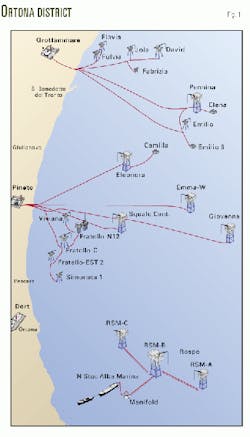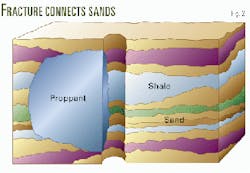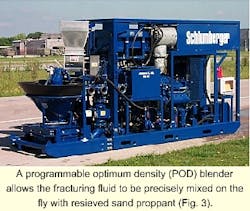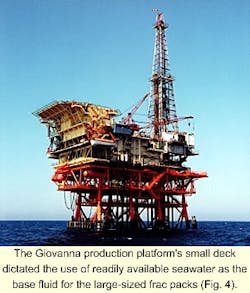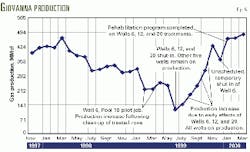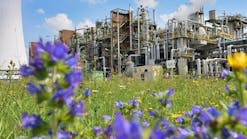A novel seawater-based, polymer-free, fluid improved the operational efficiency of 23 frac packs in Eni Agip's Giovanna field, off Italy in the Adriatic Sea.
The treatments were part of a three-well, multizone workover program, requiring large-sized fracture stimulation. These were the first successful treatments for Eni Agip that included seawater as the base fluid for Schlumberger's ClearFRAC system, a polymer-free, viscoelastic surfactant (VES) fracturing fluid.
The novel frac-pack fluid not only tripled gas production, it did so at significantly lower cost than comparable operations with conventional fracturing fluids.
The VES fluid created high fracture conductivities that led to rapid well clean up, allowing gas directly to enter the pipeline system to shore. This eliminated potential environmental problems associated with flaring, which would be required with conventional-fluid fracturing jobs.
Seawater use
Seawater has been used as a base fluid to reduce offshore fracturing costs in various parts of the world, but the treatment results have been mixed. Calcium and magnesium present in seawater could form the respective hydroxides under crosslinking conditions. This would lower the pH of the crosslinked polymeric fluid and destabilize the system.
Because the VES fluid system works at neutral pH, there is no tendency for divalent metals to form their hydroxides.
Recent offshore fracturing operations in the Adriatic Sea have demonstrated that seawater is an effective base with a simple, polymer-free VES fluid. When mixed with seawater, the surfactant fluid system acquired the desired rheological and proppant-transport characteristics for successful fracture stimulation treatments.
Unlike treatments with conventional fluids, the VES fluid consistently achieved tip screen-out (TSO) and large propped widths within the defined stress boundaries.
Seawater also reduced costs by increasing operational efficiency and saving rig and process time. Moreover, without the VES fluid's compatibility with readily available seawater, large-scale frac-pack jobs could not have been performed on the Giovanna platform because of limited freshwater storage space.
Fluid selection
In the past, Eni Agip's offshore fracturing jobs have included filtered brine, or filtered and sheared brine viscosified with hydroxyethylcellulose (HEC) polymer because these fluids suited the reservoirs encountered in its earlier Adriatic Sea ventures. These reservoirs contained relatively clean sand with clay content in the 5-20% ranges.
Eni Agip's more recently developed Giovanna field, however, contains much dirtier, lower permeability formations with clay content as high as 50% (Fig. 1). These more-complex reservoirs brought the use of HEC fracturing fluids into question.1
The main reason for fracturing Giovanna's productive reservoirs is to create a highly conductive fracture that connects the higher-permeability sand streaks deposited among numerous thin shale and silt layers (Fig. 2). Also, a highly conductive path increases near-wellbore permeabilities while decreasing the pressure differential at the wellbore so that sand and fines-free production is economically feasible.
High conductivity requires a clean, solids-free fracturing fluid.
The most common polymer fracturing fluids, guar and HEC, leave behind damaging particulate materials in the proppant pack that impair permeability, reduce treatment effectiveness, and decrease productive life.2
Fracturing treatments at Giovanna aim to create fractures with a maximum width, limited length, and contained height that does not penetrate adjacent water zones.
Polymer fluids require a high viscosity for proppant transport. In many cases, this high viscosity leads to uncontrollable fracture height growth. The VES fluid, however, reduces fracture height growth because its proppant transport capability is not viscosity related.3
To control pinchouts and near-wellbore pressure drops, Eni Agip avoids long fractures at Giovanna field.
After careful study and laboratory work, Eni Agip's fluid experts teamed with the Schlumberger in-house engineer and selected the ClearFRAC VES fluid for a pilot stimulation in Giovanna Well 6, Pool 10. This shut-in well had sanded-out completely in December 1994.
The VES fracturing fluid was selected because:
- It can carry large proppant loads even at low viscosities so that it was likely to achieve the desired tip-screen out (TSO).
- Its favorable leak-off behavior would also help promote TSO, and as a result, higher net pressures and larger propped-fracture widths.
- Its rheological characteristics would minimize the risks associated with the traditionally used, low-viscosity, non-guar fluids such as brines and HEC.
Eni Agip selected a frac pack for the Well 6 rig-less workover because gravel-pack completions, common in the area, lose their efficiency in dirty sands such as those present at Giovanna.
Although new specialized fluids for drilling and underreaming have improved openhole gravel packs, field experience from nearby, lithologically similar reservoirs indicated that a frac pack was the optimum workover method.4
A frac pack increases gas production rates by creating a short and wide propped fracture that bypasses formation skin damage and connects multiple sand layers, such as found at Giovanna. This completion method can also effectively control fines production from dirty, high-clay reservoirs.
Frac-pack program
The pilot VES frac pack in Well 6 successfully stimulated the target sand intervals, achieving tip screenout and large fracture widths within the defined stress boundaries. After the job, the calculated normalized flow rate was three times the well's initial rate.
Based on these encouraging results, Eni Agip continued with VES frac-pack workovers in Giovanna Wells 6 and 12. The nine frac packs in Well 6 and six frac packs in Well 12 were successful and based on their favorable early production results, Eni Agip then preformed eight frac packs in Well 20.
The work in these three wells took place during the latter half of 1999.
Fluid components
Unlike the initial pilot work, subsequent frac packs included a seawater base with the VES fracturing system. The treatment size along with limited freshwater storage dictated the use of seawater.
To enhance clay stabilization, the fracturing fluid included 3% potassium chloride added to the seawater. Because VES fluids are less sensitive to a variety of salts and organic materials, high concentrations of permanent and temporary clay stablizers such as cationic polymers, tetramethyl ammonium chloride, and potassium chloride can be used to minimize clay swelling.
Another fluid component was 5% methanol for reducing clay swelling. This was required in light of Giovanna's high clay content. Note that only pure methanol free of any industrial pollutants, especially higher alcohols or esters, should be used.
The VES fluid is made from one surfactant in a small group of surfactants within the family of quaternary ammonium compounds. These compounds when mixed in brine form long, worm or rod-like structures called micelles.5
At a sufficient surfactant concentration, these micelles can entangle to form a network structure that is responsible for the fluid's viscosity and proppant-transport characteristics.
By chemical definition, micelle structure formation does not depend on and is not limited to a specific salt in the base fluid. Salts such as KCl, NH4Cl, NH4NO3, and MgCl2 in addition to NaCl in seawater can be used to activate the development of the fluid's viscosity and viscoelasticity.
Salt concentration, but not the type of salt, will have an important effect on viscosity build-up. Although the presence of a single, dominant salt type is desirable, the main factor driving fluid rheology is total ion concentration. Laboratory and onsite experiences have confirmed that total salt concentrations must be maintained within an optimum range to ensure viscosity build-up.
For the Giovanna project, lab testing of midsummer Adriatic seawater mixed with various KCl amounts determined that the VES fluid system would tolerate 7% maximum total salt concentrations. As a result, 3% KCl was added to seawater both to stabilize formation clays and provide favorable viscosity for the fracturing fluid.
Because seawater salt content fluctuates depending on the season and temperature, one should monitor its salinity when planning offshore fracturing operations with seawater-based VES fluids. To ensure appropriate gelling, it is especially important to analyze the seawater if the fluid system requires additional salts and additives, such as at Giovanna.
One can obtain approximate seawater salt concentration in less than 1 min with a hydrometer. Or in about 2 min, one can determine seawater chloride concentrations with an inexpensive titration kit that uses silver nitrate and potassium dichromate as an indicator.
For the frac packs, the fracturing fluid was prepared by simply blending the liquid surfactant into the seawater. The fluid was mixed in advance and stored on a supply boat until needed.
The premixed VES fluid does not encounter problems such as those that can occur with premixed HEC and polymer fluids. Time and temperature can negatively affect HEC rheology, increasing the risk of bacterial growth and rendering the fluid unusable. VES fluids, however, are not prone to decay or bacterial degradation. They, therefore, can be batch mixed and used whenever needed.
Also, while HEC fluid needs shearing and filtering to free it of fish-eyes, the VES fluid does not require this expensive and time-consuming fluid preparation, including polymer hydration.
VES fluids can be extended or diluted anytime and their viscosity can be adjusted up or down. This can seldom be done with premixed polymer fluids.
At Giovanna, when recommended by injection test results, fracturing fluid viscosity was increased on several occasions by simply adding a small amount of surfactant to the prepared fluid. Viscosity adjustment was instantaneous, without time-consuming field operations.
This flexibility enabled fluid rheology to be modified at short notice prior to the fracture treatment, saving valuable rig time and removing some of the operational and fluid-handling risks normally encountered during fracturing operations. Moreover, the VES fluid allowed optimized treatment designs and pumping schedules.
Continuous blending
A programmable optimum density (POD) blender allows the fracturing fluid to be precisely mixed on the fly with resieved sand proppant (Fig. 3).
A programmable optimum density (POD) blender skid was used for all Giovanna frac-pack treatments. The process-controlled blender allowed the prepared seawater-based VES fluid to be mixed precisely on the fly with resieved sand proppant stored in a silo above the blender (Fig. 3).
The premixed fluid system for all nine frac packs on Well 6 was transferred onto the rig for continuous ramped blending with sand proppant as the treatments progressed. Later, improved rig-space management permitted the prepared fluids for Well 12 frac packs to be stocked on the rig, one job at a time.
The prepared VES fluid was then mixed on the fly with sand while the treatments were being pumped. This alternative set-up was considerably safer in the increasingly rough autumn seas, which prevented the supply boat from positioning itself next to the rig for significant periods.
The skid-mounted, small-size POD blender controls precisely the fracturing slurry density, which can be quickly increased by adding proppant when required. The unit is capable of blending and pumping up to 35 bbl/min. To ensure accurate fluid density, both non-radioactive and low-radiation nuclear devices provide two independently measured densities.
For uniform material distribution, a computer-controlled gate regulates the consistent and continuous addition of proppant. In a preprogrammed, automatic mode, the blender accurately mixes and meters proppant, dry additives, liquid additives, and fracturing fluid at the specified density.
The blender can control additives by their concentrations because it has both suction and discharge flow meters. By combining flow meter readings with density changes, the unit's computer can modify continuously both dry and liquid additives.
The process-controlled blender's continuous mixing capabilities eliminate equipment normally required for fracturing operations. Equipment eliminated includes precision continuous mixing (PCM) equipment or conventional blenders, stocking tanks, as well as shearing and filtering equipment and the associated personnel.
The blender does not require the averaging tub of conventional blenders. This reduces reaction time to seconds.
Mixing on the fly also permits larger treatment sizes, higher proppant concentrations, and more flexible treatment schedules for the larger, wider fractures required to bypass damage and connect sand layers.
The Giovanna proppant concentration was more than 13 ppa (lb proppant added/gal fracturing fluid), which was a record for a low viscosity (less than 20 cp) fracturing fluid. HEC fluids have attained proppant concentrations of 11 ppg, but the fluids needed high polymer concentrations and viscosities (near 100 cp).
As an example of a fluid previously used in the region, an HEC polymer concentration of 40 lb/1,000 gal corresponds to a 60-cp viscosity. This compares to the 15-cp viscosity of the VES fluid.
VES fluids can carry proppant effectively even at low viscosities because of their excellent suspension capabilities, which originate from their viscoelastic properties and chemistry rather than apparent viscosity. Laboratory tests and the Giovanna jobs clearly demonstrate this feature.
Minor proppant settling is noticed when fluid movement ceases, but the proppants immediately go back into suspension when shear-pressure is applied. Unlike polymer fluids, VES fluids are not shear degrading and any loss in viscosity because of excessive shear will be regained instantly upon lowering shear.
Cost reduction
The seawater-based VES fluid system for the three-well Giovanna stimulation program reduced costs by more than $500,000. These reductions were realized in several areas by improving efficiency, saving rig time, and eliminating certain material and equipment requirements.
The costs reduced or eliminated included:
- Freshwater purchasing, transportation, and tank-rental costs.
- Material and labor-service costs associated with purchasing and physically mixing salts into freshwater.
- Administrative costs normally encountered when freshwater volumes must be documented and reported to authorities.
Elimination of freshwater also streamlined operational logistics. The transfer of large freshwater volumes from a boat to the platform would have presented logistical and safety concerns during severe weather conditions common in the fall and early winter.
Nonproductive time would have increased significantly when rough seas and high winds would prohibit a supply boat from transferring the necessary 550-bbl freshwater needed every 3 days.
Eliminating freshwater also reduced space requirements, an important factor considering the platform's deck size (Fig. 4). The large-sized jobs would have been impossible if not for continuous seawater mixing capabilities.
Production improvements
The frac-pack stimulation has increased by a factor of three the daily gas production from the Giovanna platform (Fig. 5). After a short fracture clean-up phase, the gas production increased significantly, confirming the success of seawater-based VES stimulation.
Based on the promising early production results, Eni Agip scheduled a third well, Giovanna 20, for a complete stimulation workover with eight VES seawater frac packs. Treatment parameters have confirmed that all zones were successfully stimulated, achieving TSO, high net pressures, and large fracture widths.
The stimulated wells currently contribute 80% of the platform's daily production, verifying the successful application of the seawater-based VES fluid system implemented in conjunction with precision proppant blending and onsite design optimization and treatment engineering.
Future plans
In its search for further efficiencies at Giovanna field, Eni Agip used screenless completion technology, in conjunction with the seawater-based VES fluid system, on its last two completions within the shorter 23/8-in. string of Well 20. The dirty, tight nature of the reservoirs requires the use of sand control to prevent failure of the completion.
Eni Agip attempted screenless completions because selective gravel packs or frac packs with screens to control sand limits the number of closely spaced zones that can be completed. This procedure required tight control of proppant flow-back to prevent exchanging formation sand for proppant during production.6
For this purpose, the completion team chose Schlumberger's PropNET proppant flow-back control fibers, which have physical rather than a chemical reinforcement mechanism.
Because of Eni-Agip's early success in combining screenless completions with a seawater-based VES fracturing fluid, Giovanna and other Adriatic fields with dual-completed wells producing tightly spaced zones will surely continue to benefit from these technologies.
These technologies provide a cost-effective means to produce hydrocarbons that otherwise would have remained in the ground.
Acknowledgments
The authors thank Eni Agip and Schlumberger management for permission to publish this article. The authors also thank Enzo Pitoni, Marco Marilungo, Marco Galli, and Romilda Simone of Eni Agip for the help with this project.
References
- Pitoni, E., Burrafato, G., Devia, F., and Heitmann, N., "Polymer-free fracturing fluid revives shut-in well," World Oil, September 1999, pp. 77-82.
- Armstrong, K., Card, R., Navarrete, R., Nelson, E., Nimerick, K., Samuelson, M., Collins, J., Dumont, G., Priaro, M., Wasylycia, N., and Slusher, G., "Advanced Fracturing Fluids Improve Well Economics," Oil Field Review, Vol. 7, 1995, pp. 43-51.
- Rimmer, B., MacFarlane, C., Mitchell, C., Wolfs, H., and Samuel, M., "Fracture Geometry Optimization: Designs utilizing New Polymer- Free Fracturing Fluid and Log-Derived Stress Profile/Rock Properties," Paper No. SPE 58761.
- Pitoni, E., Copercini, P., Heitmann, N., Mysko, P., and Kelly, B., "Engineered Drill-in Fluids Deliver No-Skin Wells Offshore Gabon," Petroleum Engineer International, May 1999, pp. 46-53.
- Samuel, M., Card, R., Nelson, E., Brown, EJ., Vinod, P., Temple, H., Qu, Q., and Fu, D., "ClearFRAC, A Polymer-Free Fluid for Fracturing Applications," Paper No. SPE 38622.
- Pitoni, E., Devia, F., James, S., and Heitmann, N., "Screenless Completions: Cost-Effective Sand Control in the Adriatic Sea," Paper No. SPE 58787.
The authors
Giovanni Salerno is a completion and production engineer with Eni Agip, Ravenna, Italy. Previously, he worked Eni Agip's well-construction activities, sand-control projects in the US, and coiled-tubing fracturing operations in Canada. Salerno has a degree in petroleum engineering from Bologna University, Italy.
Fabrizio Devia is a completion and production engineer for Eni Agip, Milan, Italy. Previously, he worked on special sand-control projects in the US and on coiled-tubing fracturing operations in Canada. Devia has a degree in petroleum engineering from Bologna University, Italy.
Maurizio Noia is the drilling and completion engineering coordinator in Eni Agip's Ortona operating district in Central Italy. He is also involved with workover and rig-less projects, including the work in Giovanna. Previously, he worked in various drilling and completion areas both in Eni Agip's Milan headquarters and in its affiliate company IEOC in Egypt. Noia holds an MS in physics from the University of Genoa, Italy.
Norbert Heitmann is a senior Schlumberger DESC (Design and Evaluation Services for Clients) engineer, currently based in Eni Agip's Milan headquarters. Since joining Schlumberger in 1987, he has held various field operation and managerial positions in Italy, North Africa, and the UK. Heitmann has an MS in petroleum engineering from TU Clausthal, Germany.
Mathew Samuel is a project manager with Schlumberger in Sugar Land, Tex. He joined Schlumberger in 1996 and has served in research, field, and marketing positions. Previously, he was an assistant professor at New York University. Samuel has a PhD in chemistry from the University of Pennsylvania.
